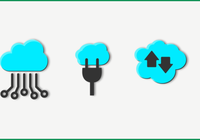Distributed file systems play a pivotal role in today's computing environments, offering essential solutions for managing and storing vast volumes of data. This article delves into the fundamental concepts of distributed file systems, uncovers the key design principles that drive their effectiveness, and gives an overview of notable distributed file systems, including Google File System (GFS), Hadoop Distributed File System (HDFS), CephFS, GlusterFS, and JuiceFS.
What is a distributed file system?
A distributed file system (DFS) is a file system implemented by multiple nodes working together, allowing users to access and manipulate files as if they were stored on their local machines. In fact, these files are stored on other computers in the network. Users do not need to be concerned with or aware of the actual storage location and method, as the distributed file system handles these complex processes automatically.
The design goals of a distributed file system primarily focus on scalability, reliability, and high performance:
- Scalability: A distributed file system should be able to easily scale to support more data, users, and computers.
- Reliability: The system can consistently perform its intended functions and deliver reliable data storage and retrieval services. It is the measure of confidence or assurance that the file system will operate correctly even when some of the nodes or components failed.
- High performance: A distributed file system should provide efficient file access. This can be achieved by distributing data and requests across different nodes.
Design principles for distributed file systems
Designing an efficient and reliable distributed file system involves considering various aspects, including data distribution strategies, consistency guarantees, fault recovery mechanisms, and concurrency control.
Data distribution strategies
Data distribution strategies determine how data is distributed across nodes in a distributed file system. They play a crucial role in achieving load balancing, maximizing performance, and ensuring fault tolerance. Here are some commonly used strategies:
- Hash-based distribution: A hash function is used to generate a unique identifier for data partitioning. The identifier determines the storage location, ensuring an even distribution of data across nodes. This approach allows for efficient retrieval and load balancing.
- Range-based distribution: Range-based distribution involves partitioning data based on a specific range, such as file size or key range. Data with similar attributes or keys are stored together, which can improve locality and query performance.
Consistency guarantees
Consistency guarantees ensure that all replicas or copies of data in a distributed file system are consistent and synchronized. Achieving consistency in a distributed environment is challenging due to factors like network delays and node failures. Let's explore two common consistency models:
- Strong consistency: It guarantees that all nodes observe the same order of operations and see the most recent state of data. Distributed consensus protocols like the Raft or Paxos algorithm are commonly used to ensure strict ordering and synchronization.
- Eventual consistency: It allows temporary inconsistencies between replicas but guarantees that all replicas will eventually converge to the same state. This model is based on techniques like vector clocks or versioning to track changes and resolve conflicts.
Fault recovery mechanisms
Fault recovery mechanisms aim to restore data availability and system functionality in the event of node failures or data corruption. Here are two commonly used mechanisms:
- Replication and redundancy: By replicating data across multiple nodes, distributed file systems ensure that if one node fails, data can still be accessed from other replicas. This redundancy improves fault tolerance and minimizes the impact of failures.
- Erasure coding: It’s a technique that breaks data into smaller fragments and adds redundancy by generating parity information. This allows for data reconstruction even if some fragments are lost or become inaccessible.
Concurrency control
Concurrency control mechanisms manage concurrent access to shared data in a distributed file system, preventing conflicts and maintaining data integrity. Let's look at three common approaches:
- Pessimistic concurrency control: Pessimistic concurrency control is a strategy that assumes conflicts will occur in a concurrent environment and takes a conservative approach to prevent conflicts. The core idea is to acquire exclusive locks or shared locks before accessing shared resources to prevent other concurrent operations from accessing the resources. This strategy is suitable for scenarios with high concurrency of read and write operations.
- Optimistic concurrency control: Optimistic concurrency control assumes that conflicts are rare, allowing multiple processes to access and modify data concurrently without acquiring locks. Changes are validated during the commit phase, and conflicts are resolved if they occur. This approach reduces contention but requires conflict detection and resolution mechanisms.
- Serialization: It is also known as serial execution and refers to the process of queuing all requests and executing them one by one in a sequential manner. It ensures that each request is processed in the order it was received, without any parallel execution or overlapping. By adopting serialization, tasks or operations are executed in a strictly linear fashion, maintaining a clear and predictable order of execution.
Notable distributed file systems
GFS
GFS is a scalable distributed file system developed by Google. It’s designed to cater to the needs of large-scale, distributed applications that require access to massive amounts of data. GFS runs on inexpensive commodity hardware and provides fault tolerance and efficient data processing. It’s used internally by Google for various purposes like web indexing.
HDFS
HDFS is a distributed file system designed for commodity hardware deployment. It serves as the primary storage system for Hadoop applications, enabling efficient data management and processing of big data. With its fault-tolerant design and focus on affordability, HDFS ensures reliable data storage and high throughput. As a key component of the Apache Hadoop ecosystem, HDFS, along with MapReduce and YARN, plays a critical role in handling large datasets and supporting various data analytics applications.
CephFS
CephFS is a POSIX-compliant file system that utilizes a Ceph Storage Cluster for data storage. It offers a highly available file store for various applications, including shared home directories, HPC scratch space, and distributed workflow shared storage. Originally developed for HPC clusters, CephFS has evolved to provide stable and scalable file storage.
GlusterFS
GlusterFS is an open source distributed file system known for its scalability and performance. It utilizes a unique no-metadata server architecture, ensuring improved performance and reliability. With modular design and flexible integration with various resources, GlusterFS provides cost-effective and highly available storage solutions. It supports multiple export options, including the native FUSE-based client, NFS, and CIFS protocols.
JuiceFS
With the popularity of cloud computing, the trend for enterprise data backup and storage is shifting towards the cloud on a large scale. In response to this shift, JuiceFS emerged as a distributed file system designed for the cloud era. It uses object storage and a versatile metadata engine to deliver scalable file storage solutions. With support for various standard access methods, JuiceFS caters to a wide range of use cases and seamlessly integrates with cloud environments.












